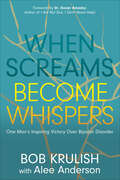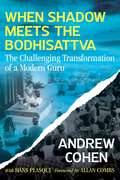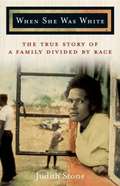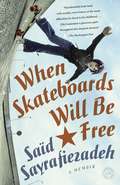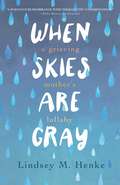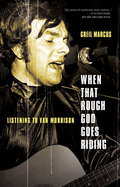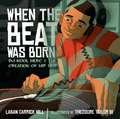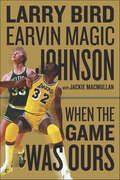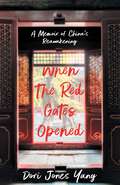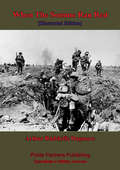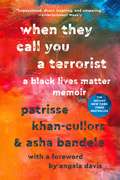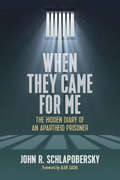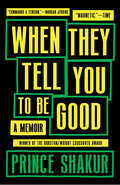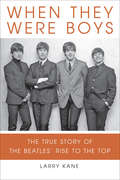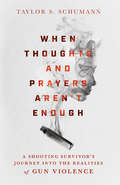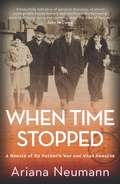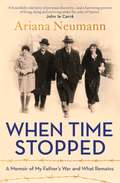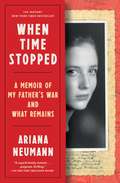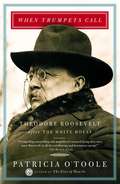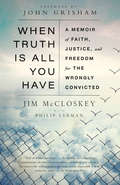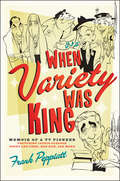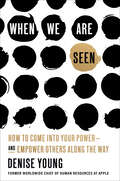- Table View
- List View
When Screams Become Whispers: One Man's Inspiring Victory Over Bipolar Disorder
by Bob Krulish Alee AndersonKrulish bravely invites readers into some of his darkest days and most painful experiences as a person living with bipolar disorder.&” —Kristin Jarvis Adams, award-winning author of The Chicken Who Saved Us When Screams Become Whispers is a memoir that offers hope to those struggling with bipolar disorder and for friends and families who continue to fight alongside their struggling loved ones. When Screams Become Whispers, a raw look at bipolar disorder and the mania it drives, will allow loved ones to recognize and understand key identifiers, thus enabling them to better help. Ultimately, Bob Krulish&’s story sheds light on the systemic problems deeply rooted in the American mental healthcare system, highlighting the danger present when treatment is not readily available. Through great storytelling, readers are gifted with a greater appreciation for the need for de-stigmatization, demystification, greater resources, and a supportive community for those suffering from this poorly understood disorder. &“This is the book of a bipolar disorder survivor [who] refused to be only that . . . He&’s living proof that you could actually live, not only survive, with bipolar.&” —Dr. Francesc Colom, PsyD, PhD, MSc, coauthor of The Psychoeducation Manual for Bipolar Disorder &“To shine light for others, Bob Krulish shares every detail of his sometimes-harrowing adventures to create stability in his life . . . He shares how to find empathy for yourself so that you can transcend mere survival and start to thrive.&” —Anthony Metivier, author of The Victorious Mind
When Shadow Meets the Bodhisattva: The Challenging Transformation of a Modern Guru
by Andrew CohenInsights from a renowned spiritual teacher&’s intense soul-searching after the dramatic collapse of his spiritual community• Explores the rise and fall of the author&’s organization EnlightenNext, including his own responsibility for its failure, and the lessons he learned, such as the need to deal thoroughly with one&’s shadow for continued spiritual growth• Presents wisdom from the author&’s discussions with spiritual leaders, including Ken Wilber, Diane Musho Hamilton Roshi, Steve McIntosh, Terry Patten, Doshin Roshi, Sally Kempton, Philip Goldberg, Jeffrey Kripal, and Patricia Albere• Shares a new vision for the spirituality of tomorrowAfter his very public fall from grace in 2013, renowned spiritual teacher Andrew Cohen vanished from view and underwent a dark night of the soul. After years of intense introspection and soul-searching, Cohen shares his insights into the failure of his organization EnlightenNext, including his own responsibility for its downfall, as well as a new vision for modern spirituality based on the wisdom of the lessons he learned. The author details his spiritual initiation, his rapid rise to guruhood, the explosive growth of his spiritual community worldwide, and then--right at the height of its spiritual and creative emergence--its dramatic collapse, which left his students lost, bitter, angry, and confused. He shares his gripping spiritual odyssey from the heights of illumination, down into the existential ashes of failed aspirations, to the underworld of inner darkness, and back again into the light.Building upon the lessons he learned, including the need to deal thoroughly with one&’s own shadow, Cohen explains the necessity of the guru in spiritual practice, while also exposing the dysfunctions of the traditional guru–disciple model. He shares insights from his discussions with spiritual leaders, including Ken Wilber, Diane Musho Hamilton Roshi, Doshin Roshi, Jeffrey Kripal, and Patricia Albere, revealing how the issues he faced are profoundly relevant to the spiritual community as a whole. He also shares how his teachings have evolved and sheds light on the art of communicating beyond ego and unleashing the co-creative power of our shared collective intelligence--the key to initiating enlightened change in a world in crisis.
When She Was White: The True Story of a Family Divided by Race
by Judith StoneDrawing on a wealth of research, including extensive interviews, this is the true story of Sandra Laing, a woman whose life was torn apart by prejudice in South Africa and healed by love.
When Skateboards Will Be Free
by Said SayrafiezadehBONUS: This edition contains a When Skateboards Will Be Free discussion guide. "The revolution is not only inevitable, it is imminent. It is not only imminent, it is quite imminent. And when the time comes, my father will lead it." With a profound gift for capturing the absurd in life, and a deadpan wisdom that comes from surviving a surreal childhood in the Socialist Workers Party, Saïd Sayrafiezadeh has crafted an unsentimental, funny, heartbreaking memoir. Saïd's Iranian-born father and American Jewish mother had one thing in common: their unshakable conviction that the workers' revolution was coming. Separated since their son was nine months old, they each pursued a dream of the perfect socialist society. Pinballing with his mother between makeshift Pittsburgh apartments, falling asleep at party meetings, longing for the luxuries he's taught to despise, Said waits for the revolution that never, ever arrives. "Soon," his mother assures him, while his long-absent father quixotically runs as a socialist candidate for president in an Iran about to fall under the ayatollahs. Then comes the hostage crisis. The uproar that follows is the first time Saïd hears the word "Iran" in school. There he is suddenly forced to confront the combustible stew of his identity: as an American, an Iranian, a Jew, a socialist... and a middle-school kid who loves football and video games. Poised perfectly between tragedy and farce, here is a story by a brilliant young writer struggling to break away from the powerful mythologies of his upbringing and create a life--and a voice--of his own. Saïd Sayrafiezadeh' s memoir is unforgettable.
When Skies Are Gray: A Grieving Mother's Lullaby
by Lindsey M. HenkeLindsey Henke is freshly married and a newly practicing psychotherapist when she finds out she is pregnant with her first child. Nine months later, on a cold Minnesota night in December 2012, after a perfect pregnancy, Lindsey goes into labor—only to be told upon arrival at the hospital that her baby has no heartbeat.After the stillbirth of her daughter, Lindsey grapples with the unbearable agony of losing a child. Unprepared to cope with a sorrow this deep, she uses the only tools she has—her skills as a therapist—to plot her own path through grief. Over the next year and half, as Lindsey mourns the loss of one child while simultaneously trying to hold space for the joy of expecting another baby, she learns that grief can live side by side with joy.When Skies Are Gray offers a poignant message to any mother who is grieving: Your pain is real. The sharp ache of the grief you feel will soften over time, though your love for the child you lost will always remain. And it&’s okay to feel that love; it&’s a mother&’s love, and like lullabies, a mother&’s love never dies.
When That Rough God Goes Riding: Listening to Van Morrison
by Greil Marcus"Van Morrison," says Greil Marcus, "remains a singer who can be compared to no other in the history of modern popular music. " When Astral Weeks was released in 1968, it was largely ignored.<P><P> When it was rereleased as a live album in 2009 it reached the top of the Billboard charts, a first for any Van Morrison recording. The wild swings in the music, mirroring the swings in Morrison's success and in people's appreciation (or lack of it) of his music, make Van Morrison one of the most perplexing and mysterious figures in popular modern music, and a perfect subject for the wise and insightful scrutiny of Greil Marcus, one of America's most dedicated cultural critics. This book is Marcus's quest to understand Van Morrison's particular genius through the extraordinary and unclassifiable moments in his long career, beginning in 1965 and continuing in full force to this day. In these dislocations Marcus finds the singer on his own artistic quest precisely to reach some extreme musical threshold, the moments that are not enclosed by the will or the intention of the performer but which somehow emerge at the limits of the musician and his song.
When The Beat Was Born: Dj Kool Herc And The Creation Of Hip Hop
by Theodore Taylor Laban Carrick Hill<P>Before there was hip hop, there was DJ Kool Herc. On a hot day at the end of summer in 1973 Cindy Campbell threw a back-to-school party at a park in the South Bronx. <P>Her brother, Clive Campbell, spun the records. He had a new way of playing the music to make the breaks--the musical interludes between verses--longer for dancing. He called himself DJ Kool Herc and this is When the Beat Was Born. <P>From his childhood in Jamaica to his youth in the Bronx, Laban Carrick Hill's book tells how Kool Herc came to be a DJ, how kids in gangs stopped fighting in order to breakdance, and how the music he invented went on to define a culture and transform the world. <b><P>A John Steptoe New Talent Award Winner <P> 2017 Texas Bluebonnet Award</b>
When The Beat Was Born: Dj Kool Herc And The Creation Of Hip Hop
by Theodore Taylor Laban Carrick Hill<P>Before there was hip hop, there was DJ Kool Herc. On a hot day at the end of summer in 1973 Cindy Campbell threw a back-to-school party at a park in the South Bronx. <P>Her brother, Clive Campbell, spun the records. He had a new way of playing the music to make the breaks--the musical interludes between verses--longer for dancing. He called himself DJ Kool Herc and this is When the Beat Was Born. <P>From his childhood in Jamaica to his youth in the Bronx, Laban Carrick Hill's book tells how Kool Herc came to be a DJ, how kids in gangs stopped fighting in order to breakdance, and how the music he invented went on to define a culture and transform the world. <b><P>A John Steptoe New Talent Award Winner <P> 2017 Texas Bluebonnet Award</b>
When The Blizzard Blows
by Kenneth JerniganThis is the seventh book in the Kernel Book Series. In these books, people who are blind share incidents from their lives and tell how they coped with them. Some are serious; some are humorous; all are thought-provoking. Other books in this series are available from Bookshare.
When The Game Was Ours (Playaway Adult Nonfiction Ser.)
by Larry Bird Earvin Magic Johnson Jackie MacMullanThe New York Times–bestseller from the Hall of Fame basketball legends. “Finally a book that tells the story of Magic and Larry from their vantage point.” —Denzel WashingtonIn Celtic green was Larry Bird, the hick from French Lick, with laser-beam focus, relentless determination, and a deadly jump shot, a player who demanded excellence from everyone and whose caustic wit left opponents quaking in their high-tops. Magic Johnson was Mr. Showtime, a magnetic personality with all the right moves. Young, indomitable, he was a pied piper in purple and gold. And he burned with an inextinguishable desire to win. When their matchup started they were bitter rivals, but along the way they became lifelong friends.With intimate, fly-on-the-wall detail, When the Game Was Ours transports readers to this electric era of 1980s basketball and reveals for the first time the inner workings of two players dead set on besting one another. From the heady days of trading championships to the darker days of injury and illness, we come to understand Larry’s obsessive devotion to winning and how his demons drove him on the court. We hear him talk with candor about playing through chronic pain and its truly exacting toll. In Magic we see a young, invincible star struggle with the sting of defeat, not just as a player but as a team leader. We are there the moment he learns he’s contracted HIV and hear in his own words how that devastating news impacted his relationships in basketball and beyond. But always, in both cases, we see them prevail.“An exhilarating ride down one of the most competitive rivalries ever.” —Pat Riley
When The Red Gates Opened: A Memoir of China's Reawakening
by Dori Jones YangA Riveting Memoir of Cross-Cultural Romance at a Pivotal Moment in History When China opened its doors in the 1980s, it shocked the world by allowing private enterprise and free markets. As a foreign correspondent for BusinessWeek, Dori Jones Yang was among the first American journalists to cover China under Deng Xiaoping, who dared to defy Maoist doctrine as he rushed to catch up with richer nations. Fluent in Mandarin, she got to know ordinary Chinese people—who were embracing opportunities that had once been unimaginable in China. This deeply personal story follows her rise from rookie reporter to experienced journalist. Her cross-cultural romance gave her deeper insights into how Deng&’s reforms led to hopes for better lives. This euphoria—shared by American businesses and Chinese citizens alike—reached its peak in 1989, when peaceful protestors filled Tiananmen Square, demanding democracy. On the ground in Beijing, Dori lived that hope, as well as the despair that followed. You&’ll be inspired by this book of empowerment about a young woman from Ohio who pushed aside barriers to become a foreign correspondent and then persevered despite setbacks. Written in a time when China&’s rapid rise is setting off fears in Washington, this book offers insight into the daring policies that started it all.
When The Somme Ran Red [Illustrated Edition]
by Arthur Radclyffe DugmoreCaptain Dugmore stands as a rather strange figure even in the mass of personalities that fought in the Great War: an artist of some standing, a writer, and traveller. When the war broke out in 1914, he visited Belgium as a private citizen; appalled by the damage that the Germans, who were overrunning country in short order at the time, were wreaking he decided to join the British Army. There was only one small problem: at the time he was forty-four, too years too old to enter the army. But he strode into his local recruiting office and demanded admission to the army, and if met with refusal, he stated, he would return with a changed appearance and falsify his age!The army accepted Mr Dugmore as an officer and sent him off for immediate training. Despite having spent a large slice of his life in the outdoors in Africa painting and writing about wildlife, he must have found the trenches a shock. As he recounts in his book, he was strafed, shot at, barraged, and gassed during his time at the front, finally wounded and passed unfit for service in 1916 during the later phases of the battle of the Somme.The author's book is excellently written, filled with anecdote and detailed battle scenes. Author -- Captain Arthur Radclyffe Dugmore 1870 - 1955Text taken, whole and complete, from the edition published in New York, George H. Doran company 1918Original Page Count - 285 pagesIllustrations -- 20 maps and illustrations
When They Call You a Terrorist (Young Adult Edition): A Story of Black Lives Matter and the Power to Change the World
by Asha Bandele Patrisse Khan-CullorsPatrisse Khan-Cullors' and asha bandele's instant New York Times bestseller, When They Call You a Terrorist is now adapted for the YA audience with photos and journal entries!A movement that started with a hashtag--#BlackLivesMatter--on Twitter spread across the nation and then across the world.From one of the co-founders of the Black Lives Matter movement comes a poetic memoir and reflection on humanity. Necessary and timely, Patrisse Khan-Cullors’ story asks us to remember that protest in the interest of the most vulnerable comes from love. Leaders of the Black Lives Matter movement have been called terrorists, a threat to America. But in truth, they are loving women whose life experiences have led them to seek justice for those victimized by the powerful. In this meaningful, empowering account of survival, strength, and resilience, Cullors and asha bandele seek to change the culture that declares innocent black life expendable.
When They Call You a Terrorist: A Black Lives Matter Memoir
by Asha Bandele Angela Davis Patrisse Khan-CullorsTHE INSTANT NEW YORK TIMES BESTSELLER.<p><p>Also: New York Times Editor’s Pick, O, Oprah’s Magazine’s “10 Titles to Pick Up Now,” Entertainment Weekly’s “13 Books to Read in January,” Cassius’ “Black Books to Add to Your Reading List,” Vogue’s “The Most Anticipated Books of January 2018,” Paste’s “10 of the Best Books of January 2018,” Bitch Magazine’s “Bitch Reads: 13 Books Feminists Should Read in January,” ELLE’s “19 of the Best Books to Read This Winter.”<p> "This remarkable book reveals what inspired Patrisse's visionary and courageous activism and forces us to face the consequence of the choices our nation made when we criminalized a generation. This book is a must-read for all of us." - Michelle Alexander, author of The New Jim Crow<p> A poetic and powerful memoir about what it means to be a Black woman in America―and the co-founding of a movement that demands justice for all in the land of the free.<p> Raised by a single mother in an impoverished neighborhood in Los Angeles, Patrisse Khan-Cullors experienced firsthand the prejudice and persecution Black Americans endure at the hands of law enforcement. For Patrisse, the most vulnerable people in the country are Black people. Deliberately and ruthlessly targeted by a criminal justice system serving a white privilege agenda, Black people are subjected to unjustifiable racial profiling and police brutality. In 2013, when Trayvon Martin’s killer went free, Patrisse’s outrage led her to co-found Black Lives Matter with Alicia Garza and Opal Tometi.<p> Condemned as terrorists and as a threat to America, these loving women founded a hashtag that birthed the movement to demand accountability from the authorities who continually turn a blind eye to the injustices inflicted upon people of Black and Brown skin.<p> Championing human rights in the face of violent racism, Patrisse is a survivor. She transformed her personal pain into political power, giving voice to a people suffering in equality and a movement fueled by her strength and love to tell the country―and the world―that Black Lives Matter.<p> When They Call You a Terrorist is Patrisse Khan-Cullors and asha bandele’s reflection on humanity. It is an empowering account of survival, strength and resilience and a call to action to change the culture that declares innocent Black life expendable.<p> Necessary and timely, Patrisse Cullors’ story asks us to remember that protest in the interest of the most vulnerable comes from love. Leaders of the Black Lives Matter movement have been called terrorists, a threat to America. But in truth, they are loving women whose life experiences have led them to seek justice for those victimized by the powerful. In this meaningful, empowering account of survival, strength, and resilience, Patrisse Cullors and asha bandele seek to change the culture that declares innocent black life expendable.
When They Came for Me: The Hidden Diary of an Apartheid Prisoner
by John R. SchlapoberskyIn 1969, while a student in South Africa, John Schlapobersky was arrested for opposing apartheid and tortured, detained and eventually deported. Interrogated through sleep deprivation, he later wrote secretly in solitary confinement about the struggle for survival. In this exquisitely written memoir, the author reflects on the singing of the condemned prisoners, the poetry, songs and texts that saw him through his ordeal, and its impact. This sense of hope through which he transformed his life guides his continuing work as a psychotherapist and his focus on the rehabilitation of others. Apartheid and its resistance come to life in this story to make it a vital historical document, one of its time and one for our own.
When They Tell You To Be Good: A Memoir
by Prince ShakurA TIME, Washington Post, Amazon, BuzzFeed, Poets & Writers, Lambda Literary, Publishers Weekly, them, The Week, Book Riot, Philadelphia Inquirer, Book and Film Globe, AllArts, and Debutiful Best Book of Fall Winner of the Hurston/Wright Crossover Award A Library Journal and Okayplayer Best Memoir of 2022 Prince Shakur’s debut memoir brilliantly mines his radicalization and self-realization through examinations of place, childhood, queer identity, and a history of uprisings. After immigrating from Jamaica to the United States, Prince Shakur’s family is rocked by the murder of Prince’s biological father in 1995. Behind the murder is a sordid family truth, scripted in the lines of a diary by an outlawed uncle hell-bent on avenging the murder of Prince’s father. As Shakur begins to unravel his family’s secrets, he must navigate the strenuous terrain of coming to terms with one’s inner self while confronting the steeped complexities of the Afro-diaspora. When They Tell You to Be Good charts Shakur’s political coming of age from closeted queer kid in a Jamaican family to radicalized adult traveler, writer, and anarchist in Obama and Trump’s America. Shakur journeys from France to the Philippines, South Korea, and elsewhere to discover the depths of the Black experience, and engages in deep political questions while participating in movements like Black Lives Matter and Standing Rock. By the end, Shakur reckons with his identity, his family’s immigration, and the intergenerational impacts of patriarchal and colonial violence. Examining a tangled web of race, trauma, and memory, When They Tell You to Be Good shines a light on what we all must ask of ourselves?to be more than what America envisions for the oppressed?as Shakur compels readers to take a closer, deeper look at the political world of young, Black, queer, and radical millennials today.
When They Were Boys: The True Story of the Beatles' Rise to the Top
by Larry KaneThis is the story of the Beatles’ harrowing rise to fame: focusing on that seven-year stretch from the time the boys met as teenagers to early 1964, when the Fab Four made their momentous first appearance on The Ed Sullivan Show. From the boys’ humble beginnings in Liverpool, to the cellars of Hamburg, When They Were Boys includes stories never before told, including the heartbreaks and the lucky breaks. Included are an eyewitness account of that first meeting between Lennon and McCartney, the inside story of how Ringo replaced Pete Best, an exploration of the brilliant but troubled soul of manager Brian Epstein, and the real scoop on their disastrous first visit to Germany and the death of Stu Sutcliffe. With an eye for life in Liverpool during the 50’s and 60’s and over 65 eyewitness accounts from those closest to the Beatles, Larry Kane brings to life the evolution of the group that changed music forever.
When Thoughts and Prayers Aren't Enough: A Shooting Survivor's Journey into the Realities of Gun Violence
by Taylor S. SchumannTaylor Schumann never thought she'd be a victim of gun violence. But one spring day a man with a shotgun walked into her workplace and opened fire on her. While she survived, she was left with permanent wounds, both visible and invisible. In When Thoughts and Prayers Aren't Enough, Taylor invites us to see what it means to be a survivor after the news vehicles drive away and the media moves on. Healing is slow and complicated. As she suffered through surgeries, grueling rehabilitation, and counseling to repair the physical injuries and emotional trauma, she came face to face with the deep and lasting impact of gun violence. As she began grappling with the realities, Taylor experienced another painful truth: Christians have largely been absent from this issue. Gun violence undercuts God's vision of abundant life and community—and the silence of the church rings loudly in the ears of survivors and families of victims. Taylor weaves her own incredible story of survival and recovery into a larger conversation about gun violence in our country. With compassion and honesty, she encourages readers to reconsider their own engagement with the issue and to join her in envisioning a more hopeful, safer future for our nation. Move beyond thoughts and prayers and enter into grace-filled dialogue and action.
When Time Stopped: A Memoir of My Father's War and What Remains
by Ariana NeumannA Simon & Schuster eBook. Simon & Schuster has a great book for every reader.
When Time Stopped: A Memoir of My Father's War and What Remains
by Ariana Neumann&‘Beautifully told' John Le Carre &‘More than just history&’ Michael Palin &‘Truly exceptional&’ Jon Snow &‘Absolutely remarkable&’ Edmund de Waal &‘Beautifully written&’ Stephen D. Smith In this remarkably moving memoir, Ariana Neumann dives into the secrets of her father&’s past: years spent hiding in plain sight in wartorn Berlin, the annihilation of dozens of family members in the Holocaust, and the courageous choice to build anew. &‘The darkest shadow is beneath the candle.&’ As a child in Venezuela, Ariana Neumann is fascinated by the enigma of her father, who appears to be the epitome of success and strength, but who wakes at night screaming in a language she doesn&’t recognise. Then, one day, she finds an old identity document bearing his picture – but someone else&’s name. From a box of papers her father leaves for her when he dies, Ariana meticulously uncovers the extraordinary truth of his escape from Nazi-occupied Prague. She follows him across Europe and reveals his astonishing choice to assume a fake identity and live out the war undercover, spying for the Allies in Berlin – deep in the &‘darkest shadow&’. Having known nothing of her father&’s past, not even that he was Jewish, Ariana&’s detective work also leads to the shocking discovery that a total of twenty-five members of the Neumann family were murdered by the Nazis.Spanning nearly ninety years and crossing oceans, When Time Stopped is a powerful and beautifully wrought memoir in which Ariana comes to know the family that has been lost – and, ultimately, her own beloved father.
When Time Stopped: A Memoir of My Father's War and What Remains
by Ariana NeumannIn this remarkably moving memoir Ariana Neumann dives into the secrets of her father&’s past: years spent hiding in plain sight in war-torn Berlin, the annihilation of dozens of family members in the Holocaust, and the courageous choice to build anew.In 1941, the first Neumann family member was taken by the Nazis, arrested in German-occupied Czechoslovakia for bathing in a stretch of river forbidden to Jews. He was transported to Auschwitz. Eighteen days later his prisoner number was entered into the morgue book. Of thirty-four Neumann family members, twenty-five were murdered by the Nazis. One of the survivors was Hans Neumann, who, to escape the German death net, traveled to Berlin and hid in plain sight under the Gestapo&’s eyes. What Hans experienced was so unspeakable that, when he built an industrial empire in Venezuela, he couldn&’t bring himself to talk about it. All his daughter Ariana knew was that something terrible had happened. When Hans died, he left Ariana a small box filled with letters, diary entries, and other memorabilia. Ten years later Ariana finally summoned the courage to have the letters translated, and she began reading. What she discovered launched her on a worldwide search that would deliver indelible portraits of a family loving, finding meaning, and trying to survive amid the worst that can be imagined. When Time Stopped is an unputdownable detective story and an epic family memoir, spanning nearly ninety years and crossing oceans. Neumann brings each relative to vivid life. In uncovering her father&’s story after all these years, she discovers nuance and depth to her own history and liberates poignant and thought-provoking truths about the threads of humanity that connect us all.
When Trumpets Call
by Patricia O'TooleFrom the author of the acclaimed Five of Hearts, this highly praised, spell-binding biography is the definitive account of TR's final decade, the most poignant -- and in some ways, the most heroic -- years of his extraordinary life. Drawn from a wealth of new materials, this is a remarkable portrait of a remarkable man.
When Truth Is All You Have: A Memoir of Faith, Justice, and Freedom for the Wrongly Convicted
by Philip Lerman Jim McCloskey"Jim McCloskey and Centurion are pioneers in the struggle to expose the tragedy of innocent people wrongly convicted and sent to prison in America...No one has illuminated this problem more thoughtfully and persistently." —Bryan Stevenson, author of Just Mercy By the founder of the first organization in the United States committed to freeing the wrongly imprisoned, a riveting story of devotion, sacrifice, and vindication.Jim McCloskey was at a midlife crossroads when he met the man who would change his life. A former management consultant, McCloskey had grown disenchanted with the business world; he enrolled at Princeton Theological Seminary at the age of 37. His first assignment, in 1980, was as a chaplain at Trenton State Prison. Among the inmates was Jorge de los Santos, a heroin addict who'd been convicted of murder years earlier. He swore to McCloskey that he was innocent—and, over time, McCloskey came to believe him. With no legal or investigative training to speak of, McCloskey threw himself into the case. Two years later, thanks to those efforts, Jorge de los Santos walked free, fully exonerated. McCloskey had found his calling. He established Centurion Ministries, the first group in America devoted to overturning wrongful convictions. Together with his staff and a team of forensic experts, lawyers, and volunteers—through tireless investigation and an unflagging dedication to justice—Centurion has freed 63 innocent prisoners who had been sentenced to life or death. When Truth Is All You Have is McCloskey's inspirational story, as well as those of the unjustly imprisoned for whom he has fought. Spanning the nation, it is a chronicle of faith and doubt; of triumphant success and shattering failure. It candidly exposes a life of searching and struggle, uplifted by McCloskey's certainty that he had found what he was put on earth to do. Filled with generosity, humor, and compassion, it is the soul-bearing account of a man who has redeemed innumerable lives—and incited a movement—with nothing more than his unshakeable belief in the truth.
When Variety Was King: Memoir of a TV Pioneer
by Frank Peppiatt<p> A humble Canadian boy who grew up to create iconic American TV shows featuring the Hollywood celebrities of the day, Frank Peppiatt made his breakthrough by developing the rock TV show Hullabuloo with his partner, John Aylesworth. That led to a writing gig for Steve Lawrence and Eydie Gormé—and then to the long-running smash hit Hee-Haw. <p>In this autobiography, he recounts a career that spanned from the 1950s to the 1980s, writing comedy and turning entertainers into household names on variety shows hosted by Jackie Gleason, Andy Williams, Judy Garland, Julie Andrews, Sonny and Cher, and Perry Como. This anecdote-filled memoir of a bygone era will enthrall anyone interested in the early decades of television.</p>
When We Are Seen: How to Come Into Your Power--and Empower Others Along the Way
by Denise YoungFrom one of the first and few women of color to reach the C-suite in Silicon Valley, Apple&’s former chief of HR and first VP of inclusion and diversity, comes a heartfelt story of growing up Black and female in a world with little regard for either and a practical road map for embodying the best in yourself and emboldening others along the way.&“You will enjoy reading this book and benefit as a business leader but mostly as a member of the human race.&”—Ron Johnson, business leader Apple, Target, JCPenneyFor her work as a co-creator of the Apple Store cultural experience, Denise Young has been deemed by leadership experts as one of the most emotionally intelligent leaders of her era. In this stirring narrative, part-memoir, part blueprint for action, she shares her vision of what it means to be truly seen at our places of work. As a &“first and only&” woman of color in boardrooms and leading roles across the Bay Area&’s booming tech industry, Denise was a trailblazer in a business that was never built for her. The first black and female senior executive under both Steve Jobs and Tim Cook, Denise was often in &“the room where it happened.&” But within a white male-centric professional culture, she still had to work harder, smarter, and differently to be heard.In When We Are Seen, Denise shares insights on using your own story, empathy, and intuition to unlock the potential in yourself and others. Her story serves as both solace and strategy for anyone who has ever felt left out, unseen, or ostracized; anyone interested in upending cycles of exclusion; and for those interested in reclaiming our agency in the ongoing quest to thrive and belong.Denise argues that bringing your truest self to work—from wearing your beloved locs to sharing your artistic passion—and, in turn, holistically seeing the attributes others have to offer is not a passive experience; it is a specific skill we can and should build. And the result is a deeper understanding of what it means to be inclusive and powerfully human on the job.
